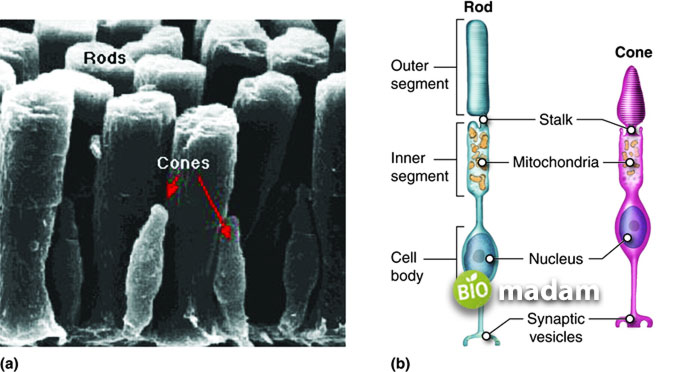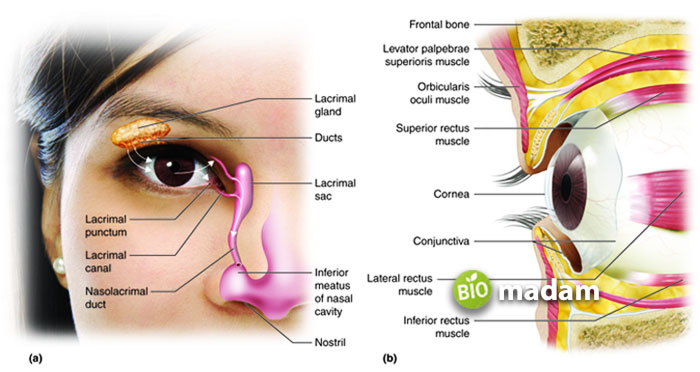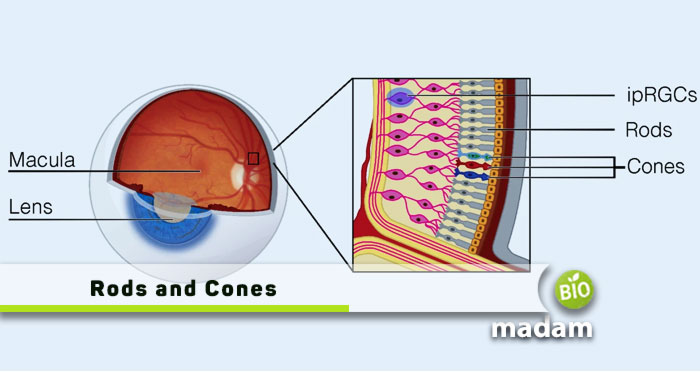Vision is one of the five basic senses in living animals and is obtained through the eyes. The eyes are a critical part of the human anatomy contributing to this critical function.
The eyes enable us to see the world by combining different components, including the iris, pupil, retina, etc. Rods and cones are also present in the eye and perform a major role in seeing objects at different light levels.
Let’s tell you the differences between rods and cones in our eyes and their functions.
Comparison Table
| Characteristics | Rods | Cones |
| Shape | Rod-like | Cone-like |
| Quantity | 120 million | 6 million |
| Location | In the periphery | In the center of retina |
| No. of Cell Types | One | Three |
| Function | Night vision | Color vision |
| Pigment | Rhodopsin | Iodopsin |
| Amount of Pigments | More | Less |
| Inner Shape | Small knob | Branched |
| Vision Type | Scotopic | Photopic |
| Light Sensitivity | High | Low |
| Speed | Slow | Fast |
| Bipolar Neuron | Multiple | Single |
| Deficiency Disorders | Night blindness | Color blindness |
What are Rods?
Rods are light-sensitive cells on the peripheral parts of the retina in vertebrates, but lack in the invertebrates. They are rod-shaped and present in surplus numbers amounting to around 120 million.
Rods are involved in scotopic vision as they sense scattered light and facilitate night vision. The wavelength of light picked by rods is between 498 and 640 nm. This is known as the Purkinje effect.
However, rods are not sensitive to color and are white-black pigment, providing monochromatic vision. They contain rhodopsin, or visual purple pigment, which is rich in vitamin A. Thus, you may be recommended vitamin A to improve nighttime vision rising from vitamin-A deficiency.
What are Cones?
Cones are also visual sensory pigments present in the eye. They are shaped like cones and are involved in color vision during the day. Compared to rods, the number of cones in the eye is quite less. Vertebrates have around 6 million cones in the retina.
They offer photopic vision due to the presence of iodopsin in the eye. It is also known as violet vision and facilitates vision under bright light. Iodopsin allows eukaryotic organisms like animals and humans to perceive various colors.
However, cones are not as sensitive to light as rods. They are able to identify and distinguish colors in the presence of bright light. Cones are sensitive to specific wavelengths of 420 nm, 534 nm, and 563 nm. And offer a faster response to light than rods.
As cones are responsible for distinguishing colors, they are categorized into three types: red, blue, and green. Red cones are the most abundant in the human eye, accounting for almost 67% of the total. 32% of the cones are green, whereas the blue cones are only 2%.
Similarities between Rods and Cones
- Rods and cones are photoreceptors in the retina
- They contain visual pigments for vision
- Both are types of secondary exteroceptor cells
Difference between Rods and Cones

Definition
Rods
Rods are photoreceptor cells present on the most peripheral part of the retina.
Cones
However, cones are light-sensitive cells responsible for the identification of color during the day.
Shape
Rods
Rods are rod-shaped photoreceptors.
Cones
Alternatively, cones are cone-shaped.
Number
Rods
Rods are found in abundance, up to 120 million in vertebrates.
Cones
On the other hand, cones are comparatively fewer in number, with 6 million cones in the retina.
Location
Rods
Rods are present in the periphery of the retina in the eye.
Cones
At the same time, cones are found in the center of the retina.
Cell Types
Rods
Rods comprise only one type of cell.
Cones
Contrarily, cones are of three types corresponding to three different colors.
Function
Rods
Rods are involved in night vision as the pigment is white-black.
Cones
However, cones facilitate the identification of different types of colors, especially during the day.
Pigments
Rods
Rods contain rhodopsin as the visual pigment. It is also known as the visual purple pigment.
Cones
On the contrary, cones have iodopsin as the visual pigment, also called the violet vision pigment.
Number of Pigments
Rods
Rods have a higher number of pigments and require less light to function.
Cones
Whereas, cones have fewer pigments than rods, requiring bright light to detect images.
Inner Shape
Rods
The inner end of the rods in the retina contains a small knob.
Cones
But, the inner end of the cones in the eye is branched.
Vision Type
Rods
Rods are used for low-intensity light conditions providing scotopic vision.
Cones
Conversely, cones help understand colors in high-light conditions offering photopic visions.
Light Sensitivity and Speed
Rods
Rods are more sensitive to light but produce a slower response.
Cones
However, on the other side, cones are less sensitive to light. Thus they require lighter, but respond faster.
Bipolar Neuron Connection
Rods
One bipolar neuron connects to multiple rods at once.
Cones
Differently, one cone is attached to each bipolar neuron of the autonomic and somatic nervous system.
Related Disorders
Rods
Insufficiency of rod cell pigment causes night blindness.
Cones
In contrast, insufficient pigments in the cone cells lead to color blindness which is a genetic disorder.
Role of Cones in Colorblindness
Damage to the cones and rods can lead to different diseases and disorders relating to vision. One such issue is color blindness. Color blindness is a genetic disorder that runs in the family.
People with color blindness cannot distinguish between certain colors. It means that you see colors differently than others. It diminishes your ability to see particular colors, understand how bright colors are, and comprehend the differences between colors.

Most people with color blindness cannot distinguish between green and red. Sometimes people might not be able to distinguish yellow and blue. In rare cases, some people with color blindness cannot see colors at all.
No cure for color blindness exists, but special glasses may help see colors.
The Bottom Line
Rods and cones are essential to nighttime vision and the detection of colors. The most significant difference between rods and cones is their contribution to vision. Rods contain rhodopsin that lets you see in low-intensity light at night. Contrarily, cones have iodopsin as the visual pigment, which helps identify colors. Insufficiency of these pigments can lead to issues like nighttime blindness and color blindness.
FAQs
Do rods or cones see color?
Rods and cones are two types of photoreceptors in the eyes that help see dim and bright lights. Cones are involved in seeing colors based on three basic green, red, and blue hues.
Do females see more colors?
While you may have heard that women can tell more colors, it is scientifically true. Studies show that women are more sensitive to colors and can see more shades than males.
Are rods sensitive to light?
Yes. Rods are more sensitive to light than cones and offer night vision even in low light. They provide easy sensitivity to shape, movement, and light and dark changes.

Hello, I would like to introduce myself to you! I am Chelsea Rogers, an experienced blog writer for science articles, holding an MPhil degree. My enthusiasm to grab the best knowledge, let it relate to botany, zoology, or any other science branch. Read my articles & let me wait for your words s in the comment section.

